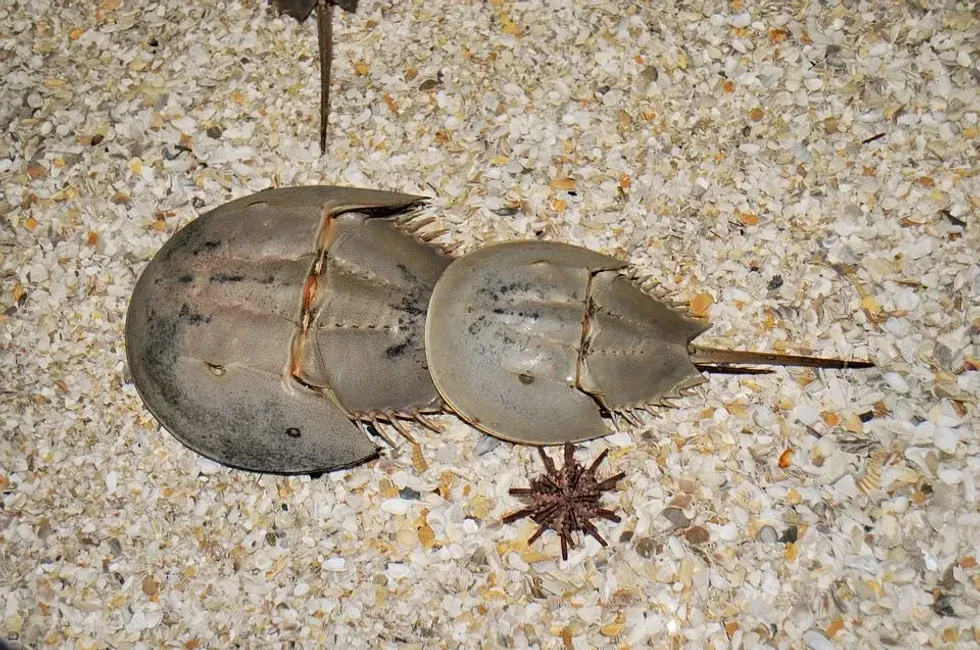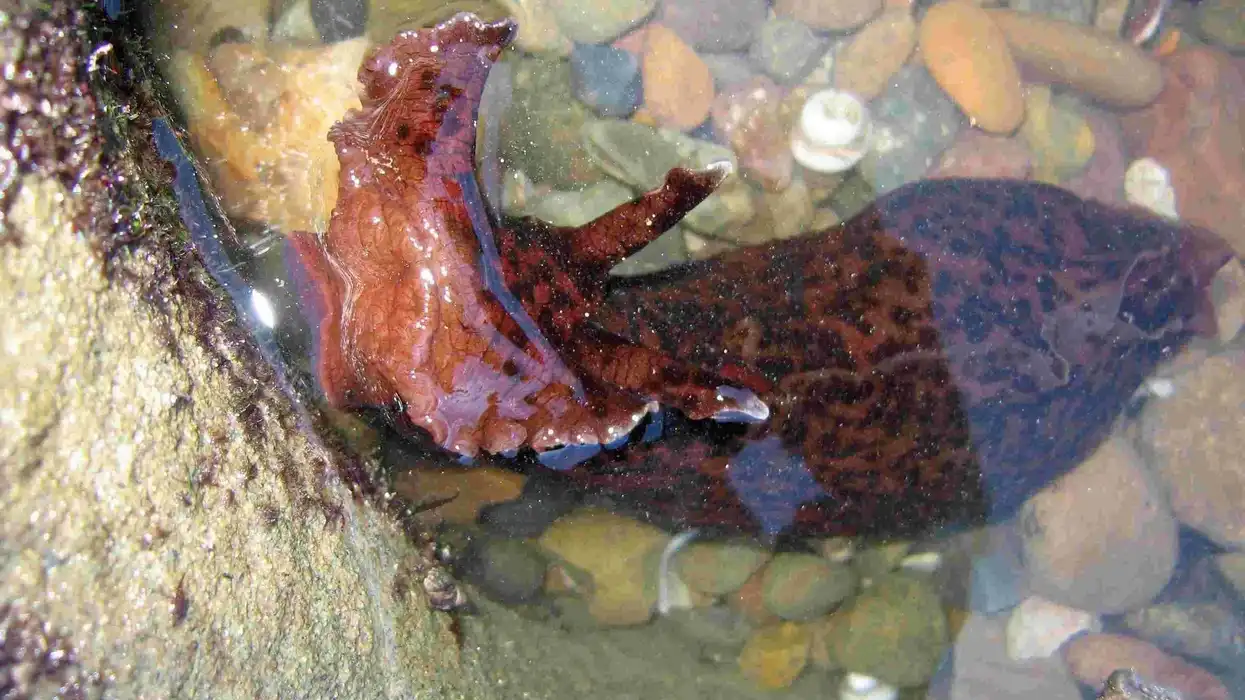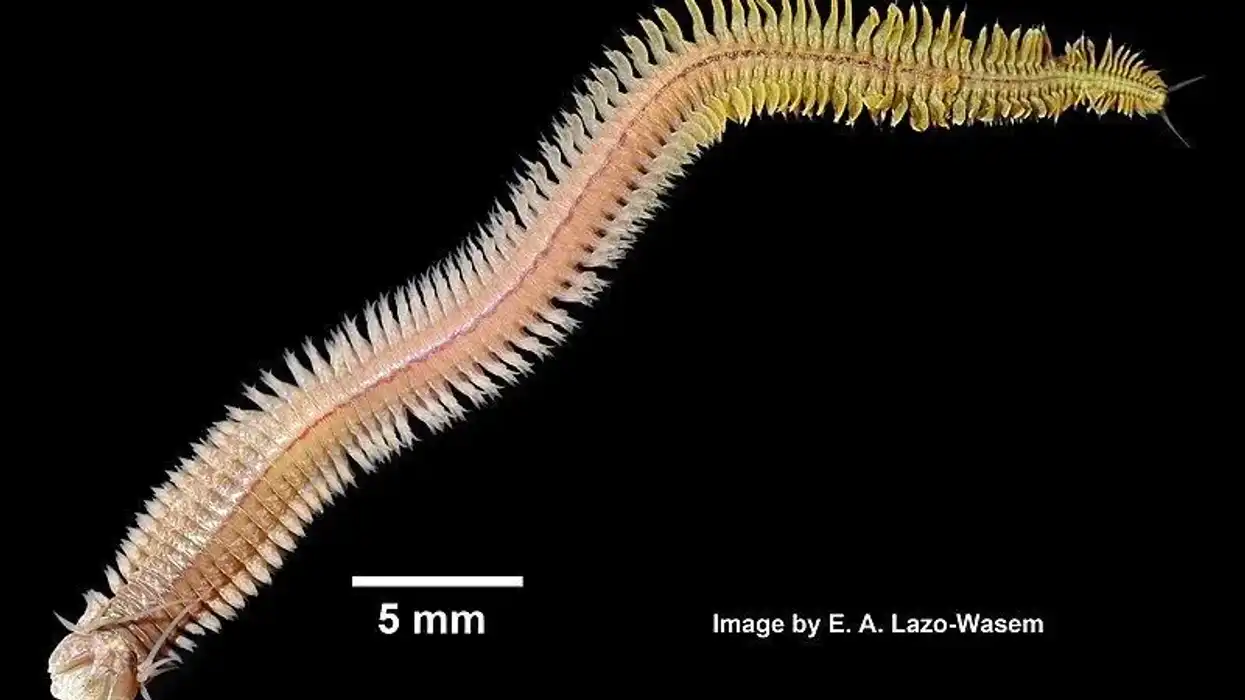Horseshoe crabs are marine arthropods with a hard shell covering their body. The horseshoe crab habitat is the ocean floor, muddy flats, brackish water, and sandy coastal waters. Although its name has the word crab these animals are closely related to spiders and scorpions.
There are four known species of horseshoe crabs and only one is found in North America. The other three inhabit coast areas of Southeast Asia. The American horseshoe crab Limulus polyphemus is also called the Atlantic horseshoe crab.
Horseshoe crabs are fascinating animals that are ancient. They are estimated to existing for the last four hundred million years or more earning the title of ‘living fossil’. They have survived the great Permian extinction which wiped out almost ninety-five percent of all existing marine species of that period.
Horseshoe crabs are important medical resources. The horseshoe crab blood uses have led to excessive harvesting of these arthropods for biomedical use.
Other than that they are used as bait for fishing, as food in Asia, and as fertilizer. These along with human activities and development along the shoreline have led to the loss of habitat over the years. That made horseshoe crab endangered as a species.
You may also check out the fact files on green crab and sally lightfoot crab from Kidadl.
Horseshoe Crab Interesting Facts
What type of animal is a horseshoe crab?
Horseshoe crabs are not true crabs or even lobsters. These arthropods are closely related to spiders and the arachnid class of invertebrates. Horseshoe crabs reach their reproductive maturity around the age of nine and before that they shed shells seventeen or times.
What class of animal does a horseshoe crab belong to?
They belong to the arthropod class. Arthropods are invertebrates like many insects, spiders, crustaceans of the large phylum Arthropoda.
How many horseshoe crabs are there in the world?
It is impossible to accurately assess the horseshoe crab population. But, it is a fact that the horseshoe crab Limulus polyphemus population has declined significantly over the last decade along the Atlantic coast and in Asia. The reasons for its population decline are many.
The horseshoe crab blood uses by the biomedical industry, use as bait for fishing, in research made them disappear fast. These animals are used as a food source in Asia. That has brought several species of horseshoe crabs to being an endangered species.
People in many southeast countries eat horseshoe crab eggs although they don’t taste great and are chewy like salty rubber. They require serious conservation efforts. Natural mortality of horseshoe crabs results from beach strandings, predation by sea turtles, sharks, and shorebirds.
Diseases also kill many adult horseshoe crabs. Beach strandings alone kill almost ten percent of the adult horseshoe crabs while spawning. Prolonged exposure to the sun, preying shorebirds, exposure to oxygen in the air are causes of deaths.
Where does a horseshoe crab live?
Horseshoe crabs are marine creatures. The horseshoe crab range is quite spread out. Four species of horseshoe crabs are found in the Atlantic Ocean, the Pacific Ocean, The Gulf coasts of Mexico.
What is a horseshoe crab's habitat?
As the name suggests the Atlantic horseshoe or the American horseshoe crab is the one found along the bays and coasts of the United States. The other three varieties are found in Asia.
The depleting population of these animals has led to planned fishery management for horseshoe crab protection. This will help the horseshoe crabs from being over-harvested for their blue blood or as a food source.
These arthropod species have survived for a few hundred million years but the disastrous pollution level, loss of habitat, unregulated harvesting, are making their populations disappear fast. Runoffs, pesticides, and herbicides from fields, hydrocarbons from agricultural, heavy metal concentrations, impact juveniles and adult horseshoe crabs adversely.
Horseshoe crabs change habitats depending on which stage of development they are in their life.
These animals come to the shallow bays and coastal beaches to lay eggs during late spring and summer. The reason is these places don’t have harsh waves crashing on their eggs.
When the juvenile horseshoe crabs hatch they move to the offshore sandy ocean floor of the nearby tidal flats and bays from their hatching grounds. The adult populations feed at a depth of the ocean till they once again come to the surface of the sandy beach for spawning.
Horseshoe crab eggs are included in the diet of several turtle species, sea birds, shorebirds, and migratory birds.
That makes them an important species within the marine ecosystem.
Horseshoe crab mating takes place along beaches of the bays mostly during a full or new moon night in spring and fall months. A major part of conserving this species includes the conservation of the natural spawning beaches, suitable deep bay waters, and intertidal nurseries.
Who do horseshoe crabs live with?
Horseshoe crabs are marine arthropods that live in gather in large numbers in their nesting and spawning grounds on sandy beaches. In the United States, they can be seen in large numbers in the Mid-Atlantic states of the country namely, New Jersey, Delaware, and Maryland.
When not mating, the horseshoe crabs like their spider and scorpion relatives lead a solitary life.
However, the juvenile or the adult horseshoe crabs do not venture very far from their hatching grounds. They move to a distance of a maximum of four miles and again come back to lay eggs in spring.
How long does a horseshoe crab live?
The horseshoe crab lifespan is more than twenty years.
How do they reproduce?
Horseshoe crabs prefer to breed in spring and summer, new and full moon, high tide, nights. These marine animals gather in large nesting groups on beaches particularly along the beaches of the Mid Atlantic states. Their numbers are a maximum in Florida most times of the year. New Jersey Maryland and Delaware beaches are their other favorite spawning spots.
As a ritual, an Atlantic horseshoe crab grasps onto the female. Then they move towards the shoreline together. Atlantic horseshoe crab females are larger than males.
During the mating ritual, the smaller male crab holds on to the female’s larger shell using its specialized front claws. The females dig nests on the sandy beach to deposit their eggs. Thereafter, the males fertilize the eggs externally.
In exceptional cases, satellite males (a special term used for the ones that don’t hook to the female) do not attach to females. They keep hanging to the attached pair and fertilize the eggs in the nest. The female horseshoe buries herself partly in the sand during spawning.
She lays a cluster of about four thousand small green eggs. She takes breaks to lay her eggs in clusters repeatedly. In one night may lay up to a hundred thousand or more eggs.
It takes several weeks for the horseshoe crab larvae to come out of their nests. The young horseshoe crabs look similar to the adult horseshoe crabs but without the tail. Most of the time the juveniles, as well as the adult horseshoe crabs live on the sandy bottoms of intertidal flats searching for food.
What is their conservation status?
The conservation status of the Atlantic horseshoe crab is as Vulnerable to extinction on the IUCN Red List of Threatened Species. The conservation status of the tri-spine horseshoe crab is classified as Endangered.
The conservation status of the other two species is unknown. Adult horseshoe crams fall prey to sea turtles, sharks, shoreline birds, alligators, and horse conchs. Other than that they are harvested for their blue blood and taken from their habitat for research.
The survival of all four horseshoe crab species depends on the conservation of their spawning habitat. Horseshoe crab sanctuaries and special programs have been designed to conserve their natural habitats in the United States.
Horseshoe Crab Fun Facts
What do horseshoe crabs look like?
Horseshoe crabs are considered to be older than dinosaurs. Horseshoe crab fossils reveal that these creatures have changed a little in their more than four million years of survival as a species.
The hard exoskeleton or the horseshoe crab shell and their ten legs help them to walk along the seafloor. The horseshoe crab anatomy is divided into three parts - the prosoma (head), opisthosoma (abdomen), and the telson (tail). The head contains the brain, largest set of eyes, glands, heart, mouth, and nervous system.
All of these are secured by a large plate. The ten horseshoe crab eyes work as light receptors helping them to detect changes in the moonlight and to move.
The marine animals have ten claws, seven pairs of legs, and are known for their unique blue blood. The muscles on the horseshoe crab underside of the abdomen help them in movement. They use gills for breathing.

How cute are they?
Horseshoe crabs have survived for more than four hundred million years, but they not considered cute in most cultures due to their hard shell and long tail.
How do they communicate?
Not being true crabs, the horseshoe crabs don’t communicate by rubbing their body parts or legs together. It is not known how these arthropods communicate.
How big is a horseshoe crab?
A horseshoe crab can grow up to 18in - 19 in compared to the biggest arthropods the coconut crabs that grow up to three feet or 36 inches. That’s double the size of some of the largest horseshoe crabs.
How fast can a horseshoe crab swim?
Horseshoe crabs moving at a speed of about 10-15 cm/s. They usually swim upside down with their body tilted at 30° to the horizontal.
How much does a horseshoe crab weigh?
Male and female horseshoe crabs can weigh from 2.2lb to 9.9lb.
What are their male and female names of the species?
The male and female horseshoe crabs have no special names.
What would you call a baby horseshoe crab?
A baby horseshoe crab is called a hatchling.
What do they eat?
The horseshoe crab diet includes immobile invertebrates and decaying organic matter. They grind up their food before passing it into their mouth. These animals with a hard shell body and a long tail roam around the brackish waters, the sandy ocean floors, soft sediments on the seabed looking for food.
Horseshoe crabs are night-eaters. Their diet includes worms, clams, small crustaceans, and even algae. The horseshoe crabs do not have teeth.
They pick their food with the appendages placed in front of the mouth. Horseshoe crabs crush their food between the legs and then put it in to the mouth to eat. With their teeth missing, the horseshoe crabs like birds have gizzards for grinding food.
Are they dangerous?
Horseshoe crabs are not dangerous at all. Though they may look ferocious, these harmless animals cannot bite or sting. The tail may look like a deadly, protective weapon but it’s not. The tail is the appendage they use to straighten themselves in case they are flipped over by strong waves.
Would they make a good pet?
Horseshoe crabs are marine animals and cannot be kept as pets.
Did you know...
Although it looks hard, the horseshoe crab shell is delicate and needs careful handling. People preserve dead horseshoe crab shells by applying coats of Mod Podge to strengthen the shell and keep them as decoration.
These ancient marine species lived from the times of trilobites, which are now extinct but considered to be one of the first known arthropods. The horseshoe crab trilobite is considered to be closely related. Images of horseshoe crab drawing are popular among tattoo enthusiasts.
Why is the horseshoe crab an example of a living fossil?
Horseshoe crabs are ancient animals that have existed for more than four hundred million years. That earns them the name of living fossils.
What is horseshoe crab blood used for?
The blue blood of horseshoe crabs is full of copper compounds that contain important immune cells. It is remarkably sensitive to toxic bacteria and is used in medical tests, research, and medicines.
The valuable horseshoe crab blood price can go up to $60,000 per gallon as it is time-consuming to harvest. Up to one-third of the animal’s blue blood can be drained out, still keeping them alive.
Here at Kidadl, we have carefully created lots of interesting family-friendly animal facts for everyone to discover! Learn more about some other arthropods including hermit crab, or king crab.
You can even occupy yourself at home by drawing one on our horseshoe crab coloring pages.










